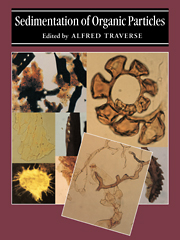Book contents
- Frontmatter
- Contents
- Editor's preface
- List of contributors
- I Introduction
- II Studies of palynosedimentation in modern environments
- III Reconstruction of late Cenozoic vegetation and sedimentary environments from palynological data
- IV Application of data on palynosedimentation to solution of geological problems
- 16 Palynology of sedimentary cycles
- 17 Particulate organic matter, maceral facies models, and applications to sequence stratigraphy
- 18 Association of palynomorphs and palynodebris with depositional environments: quantitative approaches
- 19 A quantitative approach to Triassic palynology: the Lettenkeuper of the Germanic Basin as an example
- 20 Palynomorph concentration in studies of Paleogene nonmarine depositional environments of Wyoming
- 21 Multivariate analyses of palynomorph data as a key to depositional environments of Upper Cretaceous and Paleogene coal-bearing rocks of the western United States
- 22 Relationships between depositional environments and changes in palynofloras across the K/T boundary interval
- 23 Sedimentation of palynomorphs in rocks of pre-Devonian age
- V Appendix
- Index
21 - Multivariate analyses of palynomorph data as a key to depositional environments of Upper Cretaceous and Paleogene coal-bearing rocks of the western United States
Published online by Cambridge University Press: 06 January 2010
- Frontmatter
- Contents
- Editor's preface
- List of contributors
- I Introduction
- II Studies of palynosedimentation in modern environments
- III Reconstruction of late Cenozoic vegetation and sedimentary environments from palynological data
- IV Application of data on palynosedimentation to solution of geological problems
- 16 Palynology of sedimentary cycles
- 17 Particulate organic matter, maceral facies models, and applications to sequence stratigraphy
- 18 Association of palynomorphs and palynodebris with depositional environments: quantitative approaches
- 19 A quantitative approach to Triassic palynology: the Lettenkeuper of the Germanic Basin as an example
- 20 Palynomorph concentration in studies of Paleogene nonmarine depositional environments of Wyoming
- 21 Multivariate analyses of palynomorph data as a key to depositional environments of Upper Cretaceous and Paleogene coal-bearing rocks of the western United States
- 22 Relationships between depositional environments and changes in palynofloras across the K/T boundary interval
- 23 Sedimentation of palynomorphs in rocks of pre-Devonian age
- V Appendix
- Index
Summary
Introduction
In the reconstruction of ancient environments of deposition in nonmarine rocks on the basis of palynologic data, pollen and spores produced by the local flora (plants living near the area in which sediments were deposited) can provide important information, especially on the nature of local environments. This is most true for coal beds, which are usually autochthonous, and which among all ancient deposits have the best chance for preserving a record of the local flora from its pollen and spores. Knowledge of the nature of a coal-forming environment can contribute much to understanding the origin of the coal, its quality, and its significance in paleoclimatology and geologic history.
Disregarding rare occurrences of allochthonous or transported deposits of coal, coal beds represent mires in which vegetation growing on site or in the immediately surrounding area produces the macerals, often including abundant palynomorphs, that compose the peat that is eventually coalifled. In this chapter we use the term mire to refer to wetland depositional environments characterized by accumulation of peat (Gore, 1983; see also detailed discussion of ‘mire’ in Nichols & Pocknall, Chap. 12 this volume); we use the term marsh to refer to wetland environments having aquatic vegetation and organic matter in the sediment, but without accumulation of peat (see Bates & Jackson, 1987). Studies of mires by Quaternary palynologists (e.g., Faegri & Iversen, 1975; Janssen, 1973) demonstrate that palynofloras from such depositional environments more accurately reflect the nature of the vegetation in the area than do those from most other types of sedimentary deposits.
- Type
- Chapter
- Information
- Sedimentation of Organic Particles , pp. 445 - 460Publisher: Cambridge University PressPrint publication year: 1994
- 1
- Cited by



